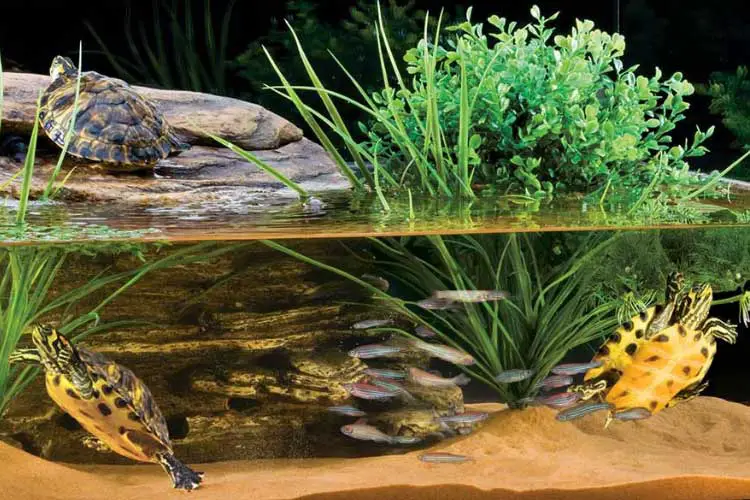Contents
- Types of Feeder Fish
- Considerations for Choosing Feeder Fish
- Feeder Fish Options Based on Turtle Size
- Special Considerations for Different Turtle Species
- Feeder Fish Preparation and Handling
- Supplementary Feeders for Turtle Diets
- Feeder Fish Risks and Concerns
- Other Factors to Consider
- Common Feeder Fish Questions
- Can I Use Fish from My Local Pet Store?
- How Many Feeder Fish Should I Feed My Turtle?
- How Often Should I Feed My Turtle Feeder Fish?
- What Do I Do If My Turtle Refuses to Eat Feeder Fish?
- Are There Any Safe Alternatives to Feeder Fish?
- Can I Raise My Own Feeder Fish?
- How Do I Store Feeder Fish?
- How Do I Thaw Frozen Feeder Fish?
- Can Feeder Fish Carry Parasites?
- Should I Dust Feeder Fish with Calcium Powder?
- Conclusion
Are you looking for the perfect feeder fish for your turtle? Look no further! This article will guide you through the process of choosing the right feeder fish to ensure a healthy and balanced diet for your aquatic friend. From discussing the different types of feeder fish to considering their size and nutritional value, we’ve got you covered. So, let’s dive in and find the ideal feeder fish for your turtle!
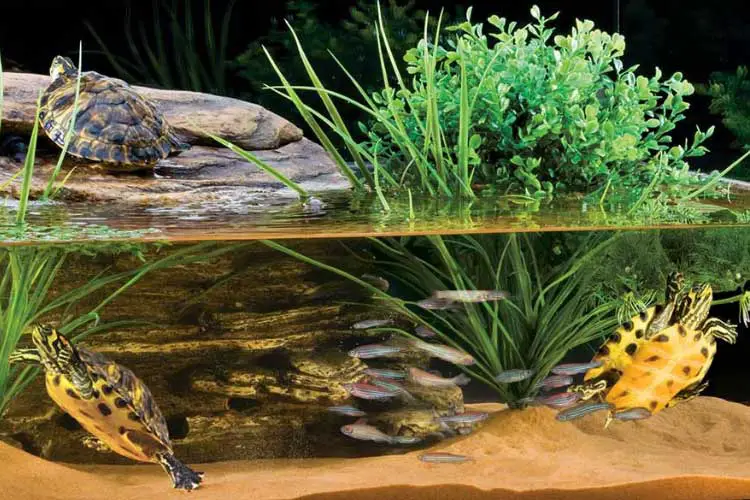
Types of Feeder Fish
Goldfish
Goldfish are a popular choice as feeder fish for turtles due to their availability and affordability. They come in various sizes, from small to large, making them suitable for turtles of different sizes. However, it’s important to note that goldfish can be high in fat, so they should be fed in moderation to avoid excessive weight gain in turtles.
Guppies
Guppies are another commonly used feeder fish for turtles. They are small in size and have vibrant colors, making them enticing for turtles. Guppies are relatively easy to breed, which can be a cost-effective option for turtle owners. It’s important to choose healthy guppies to ensure your turtle receives the necessary nutritional value.
Rosy Red Minnows
Rosy Red Minnows, also known as fathead minnows, are small fish that are often used as feeder fish. They are hardy and can tolerate a wide range of water conditions, making them easy to care for. Rosy Red Minnows are a nutritious option for turtles, providing them with essential proteins and nutrients.
Fathead Minnows
Fathead Minnows, as their name suggests, are known for their large heads. These small fish are commonly used as feeder fish due to their availability and affordability. Fathead Minnows are suitable for both small and medium-sized turtles, and they provide a good source of protein and nutrients.
Mollies
Mollies are another option to consider when choosing feeder fish for your turtle. They come in various colors and sizes, making them visually appealing. Mollies are omnivorous fish, meaning they eat both plant matter and small organisms, providing a balanced diet for turtles.
Platies
Platies are colorful fish that can make an interesting addition to your turtle’s diet. They are small in size and breed easily, making them a cost-effective option. Platies are herbivorous fish and are a good source of plant matter for your turtle’s diet.
Swordtails
Swordtails are known for their extended lower fins, resembling a sword. They are lively and colorful fish that can attract your turtle’s attention. Swordtails are omnivorous, meaning they eat both meat and plant matter, making them a nutritious addition to your turtle’s diet.
Tetras
Tetras are small, schooling fish that are commonly used as feeder fish. They come in a variety of colors and have a peaceful nature. Tetras are a good source of protein for turtles and can enhance their diet with their nutritional value.
Danios
Danios are small, active fish that can be used as feeder fish for turtles. They are known for their speed and agility, which can stimulate your turtle’s natural hunting instincts. Danios are omnivorous, providing a balanced diet for your turtle.
Feeder Fish Mixes
Feeder fish mixes are commercial blends that include a combination of different fish species suitable as feeder fish for turtles. These mixes often include a variety of small fish such as guppies, mollies, and tetras. Feeder fish mixes can provide a diverse diet for your turtle, ensuring they receive a range of nutrients.
Considerations for Choosing Feeder Fish
Size
When choosing feeder fish for your turtle, consider the size of both the fish and your turtle. Smaller turtles may need smaller feeder fish to ensure they can swallow them easily. As turtles grow, you can gradually increase the size of the feeder fish.
Health
It’s crucial to select healthy feeder fish to prevent any potential diseases or infections from being transmitted to your turtle. Look for fish that are active, have clear eyes, and show no signs of illness or physical abnormalities.
Availability
Consider the availability of feeder fish in your area. Some species may be more readily available than others, ensuring a constant supply for your turtle’s dietary needs. Check with local pet stores or reputable online sellers for a reliable source of feeder fish.
Compatibility
Ensure that the feeder fish you choose are compatible with your turtle’s species and temperament. Some fish species may be aggressive or fin-nipping, which can cause stress or harm to your turtle. Research the compatibility of different fish species with your specific turtle species before making a choice.
Nutritional Value
Feeder fish should provide your turtle with a well-rounded diet that includes essential proteins, vitamins, and minerals. Consider the nutritional value of different fish species and select a variety that can meet your turtle’s dietary requirements.
Breeding
If you’re looking for a cost-effective option, consider feeder fish that are easy to breed. Breeding feeder fish can help minimize the cost and ensure a sustainable source of food for your turtle.
Cost
Feeder fish can vary in cost depending on species, availability, and size. Consider your budget and the long-term expense of maintaining a regular supply of feeder fish for your turtle.
Lifespan
Some feeder fish have shorter lifespans than others. Consider the lifespan of the fish species you choose, as you may need to replace them more frequently. This can also impact the overall cost and convenience of providing feeder fish for your turtle.
Ease of Care
Different feeder fish species may have varying care requirements. Consider the ease of care for each species, including water temperature, feeding preferences, and tank conditions. Choose feeder fish that align with your ability to provide proper care.
Feeding Habits
Feeder fish have different feeding habits, which can affect how readily they are consumed by your turtle. Some fish may be more active and enticing, stimulating your turtle’s hunting instincts, while others may be slower or less enticing. Consider the feeding habits of different feeder fish species and choose those that are most suitable for your turtle’s preferences.
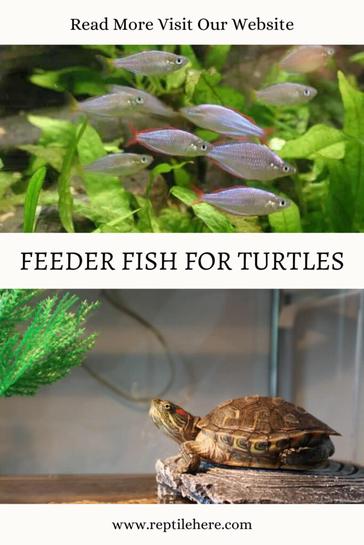
Feeder Fish Options Based on Turtle Size
Hatchlings and Young Turtles
Hatchlings and young turtles require small feeder fish that they can easily consume. Guppies, small goldfish, and rosy red minnows are popular choices for young turtles. These fish are small enough for hatchlings to comfortably eat without the risk of choking.
Medium-sized Turtles
Medium-sized turtles can handle slightly larger feeder fish. Goldfish, mollies, and platies are suitable options for medium-sized turtles. These fish provide a good balance of size and nutritional value for growing turtles.
Large Turtles
Large turtles can consume larger feeder fish. Fathead minnows, swordtails, and tetras are appropriate choices for larger turtles. These fish are bigger in size and can provide a sufficient meal for larger turtles.
Special Considerations for Different Turtle Species
Red-Eared Sliders
Red-eared sliders are a common turtle species kept as pets. They are omnivorous and require a balanced diet of both animal and plant matter. Feeder fish such as guppies, rosy red minnows, and goldfish can be included in their diet along with leafy greens and commercial turtle pellets.
Painted Turtles
Painted turtles are also omnivorous and require a varied diet. Small feeder fish like guppies, rosy red minnows, and mollies can be included in their diet, along with insects, vegetables, and commercial turtle pellets.
Map Turtles
Map turtles are primarily carnivorous and would benefit from feeder fish like guppies, rosy red minnows, and fathead minnows. Commercial turtle pellets and insects can also be part of their diet.
Box Turtles
Box turtles are omnivorous, and their diet should include a mix of animal and plant matter. Feeder fish like guppies, mollies, and swordtails can be offered to them along with insects, fruits, vegetables, and commercial turtle pellets.
Musk Turtles
Musk turtles are primarily carnivorous and require a diet rich in animal protein. Feeder fish like guppies, rosy red minnows, and fathead minnows are suitable options for them. Insects, earthworms, and commercial turtle pellets can also be included in their diet.
Snapping Turtles
Snapping turtles are carnivorous and require a diet consisting of mostly animal protein. Large feeder fish, such as fathead minnows and goldfish, can be part of their diet. Insects, crustaceans, and commercial turtle pellets should also be offered.
Softshell Turtles
Softshell turtles are primarily carnivorous and rely on a diet of animal protein. Feeder fish like fathead minnows, guppies, and rosy red minnows are appropriate choices. Insects, crustaceans, and commercial turtle pellets can also be included in their diet.
African Sideneck Turtles
African Sideneck Turtles are omnivorous and require a balanced diet. Feeder fish like guppies, platies, and swordtails can be offered, along with leafy greens, vegetables, and commercial turtle pellets.
Asian Box Turtles
Asian Box Turtles are omnivorous with a preference for animal protein. Feeder fish like guppies, mollies, and platies can be part of their diet, along with insects, vegetables, and commercial turtle pellets.
Spiny Softshell Turtles
Spiny Softshell Turtles are primarily carnivorous and need a diet consisting mostly of animal matter. Feeder fish like fathead minnows and rosy red minnows are suitable options. Insects, crustaceans, and commercial turtle pellets can also be included.
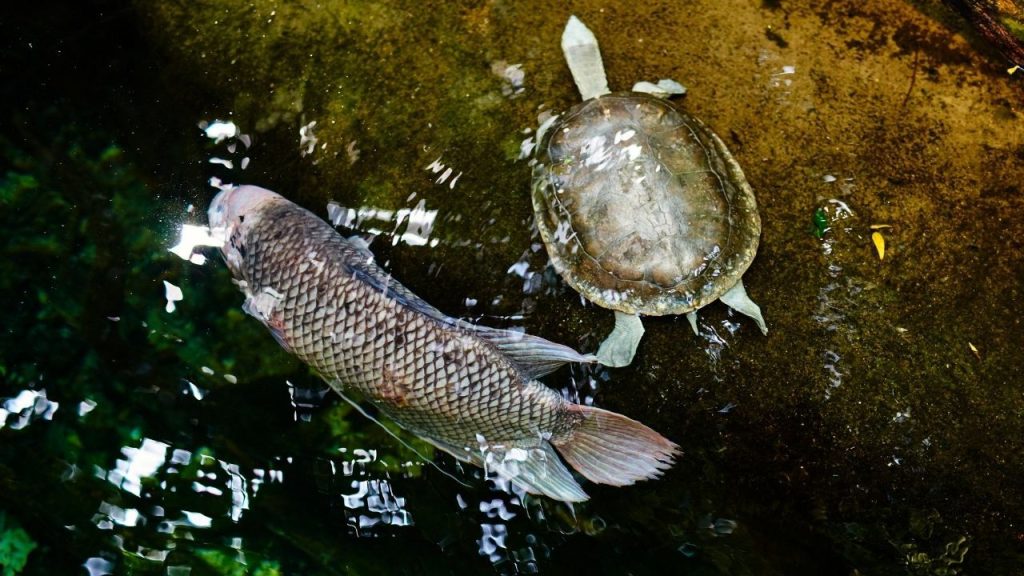
Feeder Fish Preparation and Handling
Quarantine Procedures
When introducing feeder fish to your turtle’s tank, it’s essential to quarantine them first. Quarantining the feeder fish helps to prevent the spread of potential diseases or parasites to your turtle. Keep the fish in a separate tank for a few weeks and monitor their health before introducing them to your turtle.
Proper Nutrition
Feeder fish should be nutritious for your turtle, so it’s important to offer a varied and balanced diet. If feeding live feeder fish, ensure they are healthy and well-fed before providing them to your turtle. Consider supplementing their diet with other food items to provide a diverse range of nutrients.
Avoiding Disease Transmission
Feeder fish can carry diseases or parasites that can be harmful to your turtle. To avoid disease transmission, choose feeder fish from reputable sources and monitor their health before feeding them to your turtle. Proper hygiene and tank maintenance are also essential in preventing the spread of diseases.
Preventing Contamination
Feeder fish should be kept in clean and well-maintained tanks to prevent contamination. Regularly clean their tank and provide a healthy environment for the fish to thrive. Contaminated or unclean tanks can lead to health issues for both the fish and your turtle.
Preparing Frozen Feeder Fish
Frozen feeder fish are a convenient option that eliminates the need to maintain live fish in a separate tank. Thaw the frozen feeder fish in a separate container of aquarium water before feeding them to your turtle. This ensures they are at the right temperature and more closely resemble live prey.
Alternative Feeding Options
If live or frozen feeder fish are not readily available or suitable for your turtle, there are alternative feeding options to consider. Insects, such as crickets, mealworms, and earthworms, can be offered as a nutritious substitute. Commercial turtle pellets, leafy greens, vegetables, and fruits can also be included in your turtle’s diet.
Supplementary Feeders for Turtle Diets
Insects
Insects provide a good source of protein for turtles and can stimulate their natural hunting instincts. Crickets, mealworms, waxworms, and earthworms are common insects that can be included in your turtle’s diet. Ensure the insects are gut-loaded or fed with nutritious food before offering them to your turtle.
Earthworms
Earthworms are rich in protein and make a nutritious addition to your turtle’s diet. They are easily accessible and can be purchased from bait shops or collected from your own garden. Earthworms should be thoroughly washed before feeding them to your turtle.
Commercial Turtle Pellets
Commercial turtle pellets are specially formulated to provide a balanced diet for turtles. These pellets contain essential nutrients, vitamins, and minerals that can support your turtle’s growth and overall health. Offer pellets that are appropriate for your turtle’s species and size, and ensure they are consumed within a reasonable time to avoid spoilage.
Leafy Greens
Leafy greens such as kale, spinach, and romaine lettuce can provide essential vitamins and minerals to your turtle. These greens should be thoroughly washed and torn into small pieces before feeding them to your turtle. Leafy greens should be offered as part of a varied diet and not as the sole source of nutrients.
Vegetables
Vegetables like carrots, squash, and bell peppers can be included in your turtle’s diet to provide a range of vitamins and minerals. These vegetables should be chopped into small, bite-sized pieces that are easy for your turtle to consume.
Fruits
Fruits such as strawberries, bananas, and melons can be offered as occasional treats for your turtle. These fruits provide additional variety to the diet and can be a source of natural sugars and antioxidants.
Commercial Gel Foods
Commercial gel foods are available as pre-packaged mixtures or can be made at home using gelatin and a combination of nutrients. These foods provide a convenient and balanced supplement to your turtle’s diet. Follow the manufacturer’s instructions or a trusted recipe when preparing gel foods for your turtle.
Calcium and Vitamin Supplements
Calcium and vitamin supplements can be added to your turtle’s diet to ensure they receive all the necessary nutrients. These supplements can help prevent calcium deficiencies and promote healthy shell and bone development. Consult with a reptile veterinarian to determine the appropriate dosage for your turtle’s specific needs.
Commercial Frozen Turtle Diets
Commercial frozen turtle diets are pre-packaged blends of various food items. These diets typically contain a combination of meats, vegetables, and other nutrients that provide a balanced meal for your turtle. Follow the manufacturer’s instructions for thawing and serving the frozen diet to your turtle.
Fresh Raw Fish
Fresh raw fish can be offered as a supplementary food item for your turtle. Fish like salmon, halibut, and tilapia can provide additional protein and omega-3 fatty acids. Ensure the fish is fresh, properly cleaned, and boneless before feeding it to your turtle.
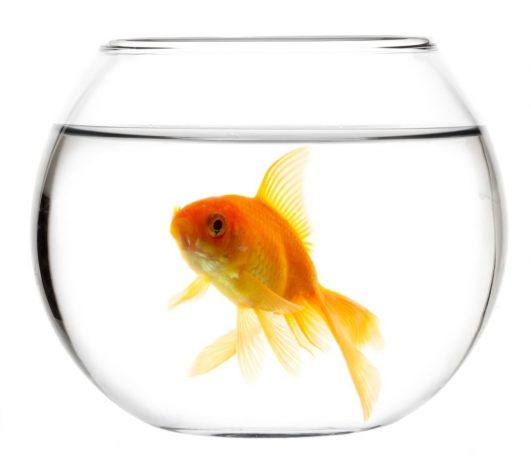
Feeder Fish Risks and Concerns
Spread of Diseases
Feeder fish can carry diseases or parasites that can be transmitted to your turtle. To minimize the risk, choose feeder fish from reputable sources and quarantine them before introducing them to your turtle. Regularly monitor the health of your turtle and seek veterinary care if you notice any signs of illness.
Parasite Infections
Feeder fish can harbor parasites that can infect your turtle if consumed. It’s important to choose healthy feeder fish and maintain proper hygiene and tank conditions to minimize the risk of parasite infections. Regular veterinary check-ups can help detect and treat any potential parasite infections in your turtle.
Presence of Contaminants
Feeder fish should be sourced from clean and reliable sources. Avoid feeder fish from questionable or untrustworthy suppliers, as they may contain contaminants that can be harmful to your turtle. Proper hygiene, tank maintenance, and feeding practices can also help prevent the presence of contaminants in feeder fish.
Choking Hazards
Feeder fish should be an appropriate size for your turtle to swallow comfortably. Offering fish that are too large can pose a choking hazard and potentially harm your turtle. Gradually increase the size of the feeder fish as your turtle grows to ensure they can safely consume them.
Inadequate Nutritional Value
Feeder fish alone may not provide all the necessary nutrients for your turtle’s diet. It’s important to offer a varied diet that includes other food items such as insects, vegetables, and commercial turtle pellets. This ensures your turtle receives a balanced and nutritious diet.
Overfeeding Issues
Feeder fish should be offered in moderation to prevent overfeeding and obesity in turtles. Feeding your turtle too many feeder fish can lead to weight gain and related health issues. Monitor your turtle’s weight and adjust the feeding schedule accordingly to maintain a healthy weight.
Excessive Fatty Acids
Certain feeder fish, such as goldfish, can be high in fat. Feeding your turtle excessive amounts of fatty feeder fish can lead to weight gain and potential health issues. Balance the consumption of fatty fish with other leaner options to maintain a healthy diet for your turtle.
Environmental Impact
The sustainability and environmental impact of using live feeder fish should be considered. Some feeder fish species may be harvested from wild populations, potentially impacting their overall population and ecosystem. When possible, choose feeder fish that are sustainably sourced or consider alternative feeding options.
Ethical Considerations
Using live feeder fish for your turtle’s diet can raise ethical concerns for some individuals. If you have specific ethical considerations, explore alternative feeding options such as commercially available diets, insects, or plant-based food items. Consult with a reptile veterinarian to determine the most suitable diet for your turtle.
Alternatives to Live Feeder Fish
If live feeder fish are not a viable option or raise ethical concerns, there are alternative feeding options available. Insects, commercially available diets, and plant-based food items can provide your turtle with a nutritional diet without the need for live fish. Consult with a reptile veterinarian to determine the best alternative feeding options for your turtle.
Other Factors to Consider
Growth Rates
Different fish species have varying growth rates. Consider the growth rates of different feeder fish to ensure a sustainable supply for your turtle’s dietary needs. Some fish species may reach adulthood faster, while others may take longer to reach a suitable size for feeding.
Quality of Fish
Choose feeder fish from reputable sources and ensure they are healthy and well-cared for. Healthy fish will have clear eyes, active swimming behavior, and no signs of illness or physical abnormalities. Quality feeder fish will provide the necessary nutritional value for your turtle’s diet.
Source of Feeder Fish
The source of your feeder fish can impact their overall health and quality. Reputable pet stores, specialty breeders, or trusted online sellers are good sources for healthy feeder fish. Avoid purchasing feeder fish from questionable or untrustworthy sources that may offer low-quality fish.
Feeding Frequency
Consider how often you plan to feed your turtle feeder fish. Feeder fish can be fed as a primary food source or as a supplementary item in your turtle’s diet. The feeding frequency should be appropriate for your turtle’s age, size, and species.
Variety in Diet
Offer a variety of feeder fish species to provide your turtle with a diverse diet. Feeding different species of fish can help prevent nutritional deficiencies and offer a range of flavors and textures for your turtle’s enjoyment.
Storage and Maintenance
Feeder fish should be stored properly to ensure their freshness and quality. Frozen feeder fish should be kept in a freezer at the appropriate temperature, while live feeder fish should be maintained in a clean and well-maintained tank. Regularly monitor and maintain the storage conditions to prevent spoilage or contamination.
Feeding Techniques
Consider different feeding techniques to ensure your turtle consumes the feeder fish effectively. Some turtles may be more active hunters and enjoy chasing live fish, while others may require hand-feeding or alternative feeding methods. Observe your turtle’s behavior and adjust the feeding technique accordingly.
Observing Feeding Behavior
Monitor your turtle’s feeding behavior to ensure they are consuming the feeder fish properly. Some turtles may take longer to eat or may show signs of disinterest in certain fish species. Pay attention to any changes in appetite or eating patterns and consult with a reptile veterinarian if you have concerns.
Adjusting Feeder Fish Size
As your turtle grows, you may need to adjust the size of the feeder fish you offer. Smaller turtles may require smaller feeder fish to ensure proper swallowing and digestion. Gradually increase the size of the feeder fish as your turtle grows to provide a suitable meal.
Monitoring Weight and Health
Regularly monitor your turtle’s weight and overall health to ensure they are receiving an appropriate diet. Weight gain or loss, changes in appetite, or signs of illness can indicate issues with their feeding habits or nutrition. Consult with a reptile veterinarian if you have concerns about your turtle’s weight or health.
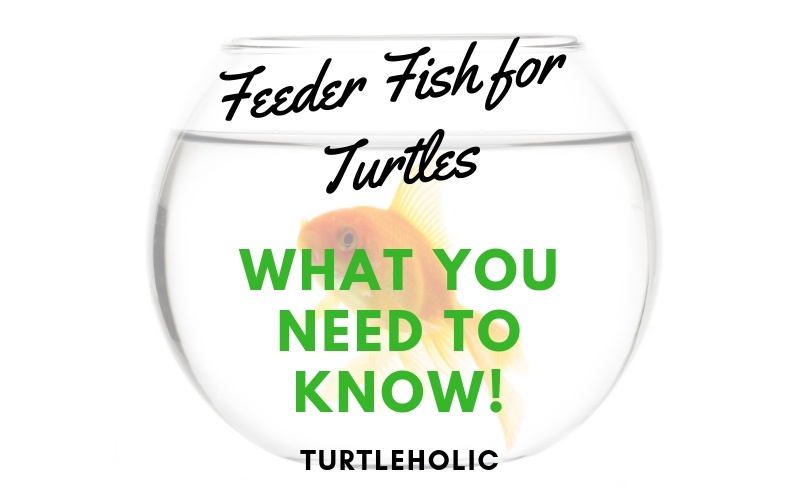
Common Feeder Fish Questions
Can I Use Fish from My Local Pet Store?
Fish from reputable pet stores can be suitable as feeder fish for your turtle. Ensure the fish are healthy, active, and suitable for your turtle’s diet. Avoid using fish from pet stores with a questionable reputation or those that may have been exposed to potential diseases.
How Many Feeder Fish Should I Feed My Turtle?
The number of feeder fish to feed your turtle can vary depending on its size, species, and nutritional requirements. It’s important to avoid overfeeding and consider the nutritional value of the feeder fish. Consult with a reptile veterinarian to determine the appropriate feeding amount for your specific turtle.
How Often Should I Feed My Turtle Feeder Fish?
Feeding frequency will depend on your turtle’s age, size, species, and overall health. Young turtles may require more frequent feedings, while adult turtles may have a different feeding schedule. It’s generally recommended to feed turtles two to three times a week, adjusting the frequency as needed.
What Do I Do If My Turtle Refuses to Eat Feeder Fish?
If your turtle refuses to eat feeder fish, there may be several reasons. It could be due to a lack of interest, health issues, or the specific preferences of your turtle. Consider offering alternative food items or consult with a reptile veterinarian to address any underlying issues.
Are There Any Safe Alternatives to Feeder Fish?
Yes, there are alternative feeding options that can be suitable for turtles. Insects, commercially available turtle diets, leafy greens, vegetables, and fruits can provide a well-rounded diet without the need for feeder fish. Consult with a reptile veterinarian to determine the best alternative diet for your turtle.
Can I Raise My Own Feeder Fish?
Raising your own feeder fish can be a cost-effective and sustainable option. It allows you to have more control over the quality and nutrition of the fish. Research the breeding requirements of the desired fish species and ensure you can provide appropriate care and maintenance for them.
How Do I Store Feeder Fish?
Live feeder fish should be kept in a separate tank with clean, filtered water and proper lighting. Ensure the tank is large enough to accommodate the fish comfortably. Frozen feeder fish should be stored in a freezer at the recommended temperature to maintain their freshness and quality.
How Do I Thaw Frozen Feeder Fish?
Thaw frozen feeder fish by placing them in a separate container with aquarium water. This allows the fish to thaw at the appropriate temperature and ensures they resemble live prey. Avoid thawing feeder fish at room temperature or using hot water, as this can impact their quality and nutritional value.
Can Feeder Fish Carry Parasites?
Yes, feeder fish can carry parasites that can be harmful to your turtle. Choosing healthy feeder fish from reputable sources and maintaining proper tank hygiene can help minimize the risk of parasite infections. Regular veterinary check-ups can also help detect and treat any potential parasite infestations in your turtle.
Should I Dust Feeder Fish with Calcium Powder?
Feeder fish may not require calcium powder if they are already a good source of calcium. However, if you are concerned about your turtle’s calcium intake, consult with a reptile veterinarian. They can provide guidance on the proper use of calcium powder or supplements for your turtle’s specific needs.
Conclusion
Choosing the right feeder fish for your turtle is an important decision that impacts their health and overall well-being. Consider the size, nutritional value, availability, compatibility, and other factors to make an informed choice. Remember to consult with a reptile veterinarian to ensure your turtle receives a balanced and nutritious diet throughout their life. By choosing wisely, balancing feeder fish with other food items, and monitoring your turtle’s feeding habits, you can provide them with a healthy and fulfilling diet.

